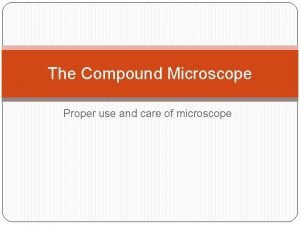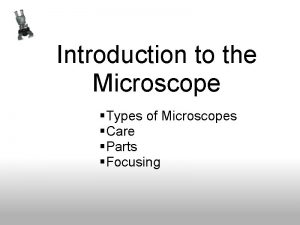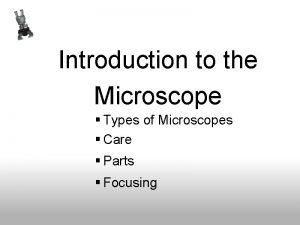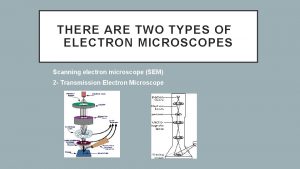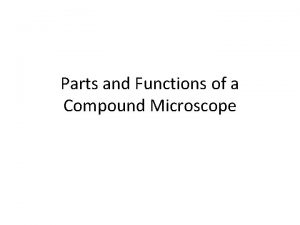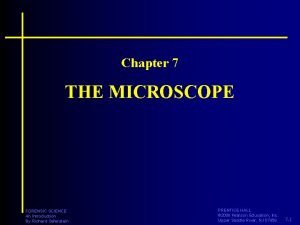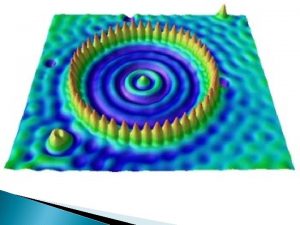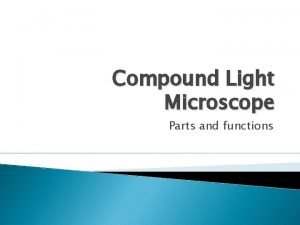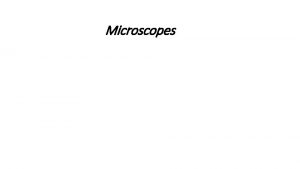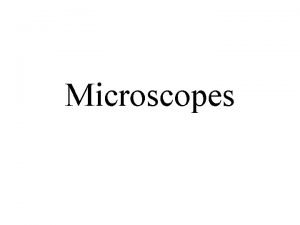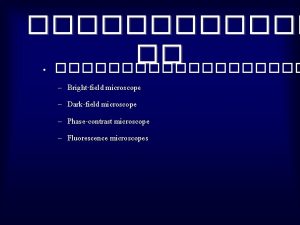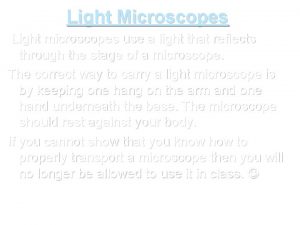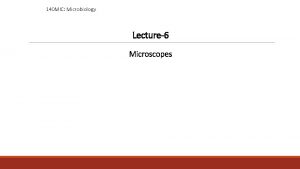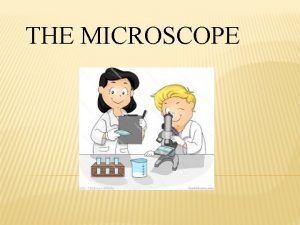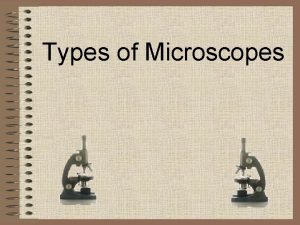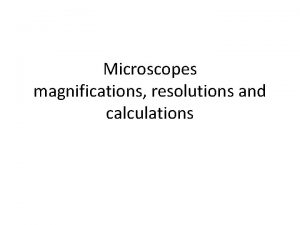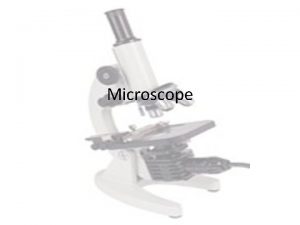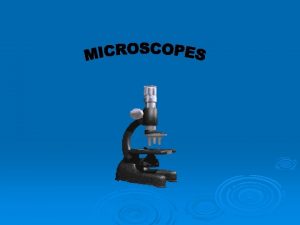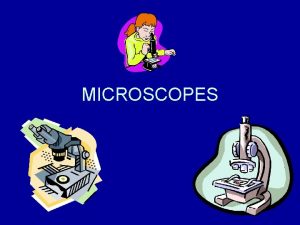Microscopes THEIR TYPES AND USES Light microscope Key

















- Slides: 17

Microscopes THEIR TYPES AND USES

Light microscope Key: A=ocular lens area B=objective lens area C and D - slide and stage opening E=mechanical stage F=light source

Dark Field Darkfield microscopy is a specialized illumination technique that capitalizes on oblique illumination to enhance contrast in specimens that are not imaged well under normal brightfield illumination conditions. Basic concepts of microscopy

Phase Contrast Basic concepts of microscopy

Electron microscope

Types of electron microscopes Transmission electron microscopes pass a beam of electrons through the specimen. Electron gun Thin sections of specimen are needed for transmission electron microscopy as the electrons have to pass through the specimen for the image to be produced. Dense areas stop the electrons and appear dark. Specimen Monitor Sensor

Types of electron microscopes Scanning electron microscopes pass a beam of electrons over the surface of the specimen in the form of a ‘scanning’ beam. Larger, thicker structures can thus be seen under the scanning electron microscope as the electrons do not have to pass through the sample in order to form the image. However the resolution of the scanning electron microscope is lower than that of the transmission electron microscope. Monitor Electron gun r o s n e S Specimen Electrons are reflected creating a 3 D image of troughs and ridges

Scanning vs transmission

Electron microscopes Better resolution: The ability to distinguish between two points on an image. Like pixels in a digital camera. Greater magnification: How much bigger a sample appears to be under the microscope than it is in real life.

Same magnification, different resolution Light microscope Scanning electronmicroscope


What microscope to use ? Light Electron Cheap to purchase (200 – 1000 $) Expensive (over 2, 000$) Cheap to operate Expensive to produce electron beams Small and portable Large and requires special rooms Simple and easy preparations Lengthy and complex preparations Material rarely distorted by preparation Preparation distorts material Vacuum is not required Vacuum is required Natural color maintained All images in black and white Magnifies objects only up to 2000 times Magnifies over 500, 000 times

Magnification and scale bars Magnification = Magnified size(ruler) Real size (scale bar) Scale bar = 10 µm

DETERMINING THE SIZE OF CELLS Using a graticule

Calibration How much is each division on the graticule worth? This depends on the magnification! Use the lowest Graticule magnification. We do not have a stage micrometer so we will need to use a transparent ruler where the smallest unit is in mm. At 20 x magnification: 5 mm = 5000µm ∴ each division on the graticule is equal to: 5000/100 = 50µm It is easier to turn the eyepiece to align the graticule with the ruler.

The values for the graticule will decrease as we increase the magnification. In the case given on the previous page: Magnification Calculation Graticule value per smallest division x 20 x 100 x 400 See previous slide 50µm (20/100) x 50µm 10µm (20/400) x 50µm 2. 5µm Each microscope needs to be calibrated separately.

Determining the size of cells (onion epidermis) Once you have calibrated the graticule, determine the length and width of an onion epidermis cell. Measuring the length of many cells and calculating the mean will give a more reliable estimate!
 Uses of compound microscope
Uses of compound microscope Types of microscopes
Types of microscopes Light microscope vs electron microscope
Light microscope vs electron microscope Microscope mania compound light microscope
Microscope mania compound light microscope Types of microscopes
Types of microscopes Types of electron microscope
Types of electron microscope When focusing a specimen you should always start with the
When focusing a specimen you should always start with the Function of draw tube in microscope
Function of draw tube in microscope Light light light chapter 23
Light light light chapter 23 Light light light chapter 22
Light light light chapter 22 Light light light chapter 22
Light light light chapter 22 Microscopes brainpop quiz answers
Microscopes brainpop quiz answers Purpose of microscopes
Purpose of microscopes Forensic science microscopes
Forensic science microscopes Which of the following enclose their dna in a nucleus
Which of the following enclose their dna in a nucleus Electron microscopes main idea
Electron microscopes main idea Burs used in crown preparation
Burs used in crown preparation The compound light microscope parts and functions
The compound light microscope parts and functions
